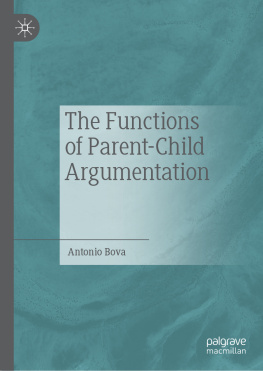Contents
Landmarks

Antonio Bova
The Functions of Parent-Child Argumentation
Antonio Bova
Department of Psychology, Universit Cattolica del Sacro Cuore, Milan, Italy
ISBN 978-3-030-20456-3 e-ISBN 978-3-030-20457-0
https://doi.org/10.1007/978-3-030-20457-0
The Editor(s) (if applicable) and The Author(s), under exclusive license to Springer Nature Switzerland AG 2019
This work is subject to copyright. All rights are solely and exclusively licensed by the Publisher, whether the whole or part of the material is concerned, specifically the rights of translation, reprinting, reuse of illustrations, recitation, broadcasting, reproduction on microfilms or in any other physical way, and transmission or information storage and retrieval, electronic adaptation, computer software, or by similar or dissimilar methodology now known or hereafter developed.
The use of general descriptive names, registered names, trademarks, service marks, etc. in this publication does not imply, even in the absence of a specific statement, that such names are exempt from the relevant protective laws and regulations and therefore free for general use.
The publisher, the authors and the editors are safe to assume that the advice and information in this book are believed to be true and accurate at the date of publication. Neither the publisher nor the authors or the editors give a warranty, expressed or implied, with respect to the material contained herein or for any errors or omissions that may have been made. The publisher remains neutral with regard to jurisdictional claims in published maps and institutional affiliations.
This Palgrave Macmillan imprint is published by the registered company Springer Nature Switzerland AG
The registered company address is: Gewerbestrasse 11, 6330 Cham, Switzerland
For Laura and Livia
Contents
List of Figures
Fig. 2.1 The Y-structure representing the AMTs reconstruction of an argument advanced by a mother during a discussion with her 5-year-old son, Leonardo
Fig. 4.1 AMT-based reconstruction of the argument advanced by the mother: The salad is nutritious
Fig. 4.2 AMT-based reconstruction of the argument advanced by the father: You have not eaten enough
Fig. 4.3 AMT-based reconstruction of the argument advanced by the mother: Today you said that you had so much fun
Fig. 4.4 AMT-based reconstruction of the argument advanced by the mother: When you were a baby you used to like it
Fig. 4.5 AMT-based reconstruction of the argument advanced by the father: How can you say that you do not like it if you have never tried it?
Fig. 4.6 AMT-based reconstruction of the argument advanced by the mother: This is the one Grandpa bought
Fig. 4.7 AMT-based reconstruction of the argument advanced by the mother: Mom needs the lemons
Fig. 4.8 AMT-based reconstruction of the argument advanced by the mother: Dad wants to eat a good salad today
Fig. 4.9 AMT-based reconstruction of the argument advanced by the mother: If Ms. Chiara (the Italian teacher) did not give homework to do during the Christmas holidays, neither will Ms. Marta (the Math teacher)
Fig. 4.10 AMT-based reconstruction of the argument advanced by the child, Luca: The soup was too much
Fig. 4.11 AMT-based reconstruction of the argument advanced by the child, Adriana: The bread is hard
Fig. 4.12 AMT-based reconstruction of the argument advanced by the child, Francesco: The teacher told me that I have to read silently
Fig. 4.13 AMT-based reconstruction of the argument advanced by the child, Stefano: Tommasos Dad told me that I could
Fig. 4.14 AMT-based reconstruction of the argument advanced by the child, Samuele: But if before you (Mom) also said that you do not want the fruit!
List of Tables
Table 2.1 Sub-corpus 1Italian families
Table 2.2 Sub-corpus 2Swiss families
The Author(s) 2019
Antonio Bova The Functions of Parent-Child Argumentation https://doi.org/10.1007/978-3-030-20457-0_1
1. Introduction
Antonio Bova
(1)
Department of Psychology, Universit Cattolica del Sacro Cuore, Milan, Italy
Why do parentchild argumentative interactions matter? What is the reason for such an interest? This chapter provides the reasons that motivated the study of parentchild argumentation with the aim to understand the function of this type of interactions. Focusing on the activity of family mealtime , in the first part, the chapter draws attention to the distinctive features of parentchild conversations. A second section of the chapter is devoted to discussing whether and, eventually, when children have the competence to construct arguments and engage in argumentative discussions with the aim to convince their parents to change opinion. In the last part of the chapter, research questions and structure of the volume are presented.
1.1 Introduction
Ten years ago, in a volume concerning the role of argumentative practices in the educational sphere, Muller Mirza, Perret-Clermont, Tartas and Iannaccone (, p. 76) stressed that the argumentative attitudes learned in the family are to be considered the matrix of all other forms of argumentation. The thesis sustained by these authors has not remained isolated, because, since then, parent child interactions have been considered by many scholars coming from different disciplines as an important object of investigation for the study of argumentative practices. What is the reason for such an interest? Why do parentchild argumentative interactions matter? Is it because the family environment, like the school environment, is for children one of the first spaces for learning argumentative skills, or, instead, there is, also, a different reason? To answer this question, in this volume, we will try to understand the function of these types of interactions. Understanding the function of parentchild argumentation will help to clarify the reasons why it matters.
An important decision at the base of this volume is what kind of interactions between parents and children to analyze. The choice to consider as the object of research of the present study the conversations between parents and children during mealtime is indeed not casual. This choice is based on the fact that the activity of mealtime represents a privileged moment for studying the argumentative interactions between parents and children because it is one of the few moments during the day in which all family members come together and engage in verbal interactions. Mealtime is a densely packed event in which much has to happen in approximately twenty minutes (Fiese, Foley, & Spagnola, ). The parents could easily avoid engaging in a discussion by advancing arguments in support of their standpoint , and yet resolve the difference of opinion in their favor, forcing children to accept, perhaps unwillingly, their standpoint . The difference in age, role, and skills with their children would allow them to do so. Now, it is evident that this happens frequently. However, equally frequently during mealtime , we can observe argumentative discussions , in which parents and children put forward arguments to convince the other party that their standpoint is more valid, and, accordingly, deserves to be accepted. By reading this volume, the readers will find out why this happens.















